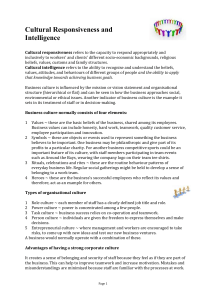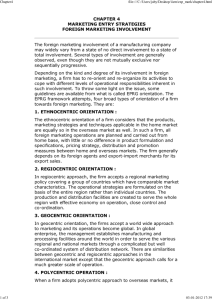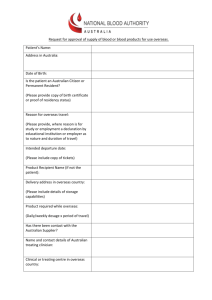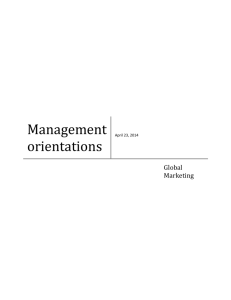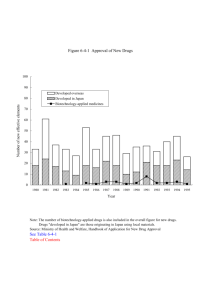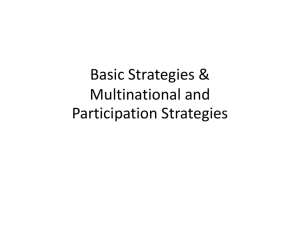UNIT I - Banshi College of Education
advertisement
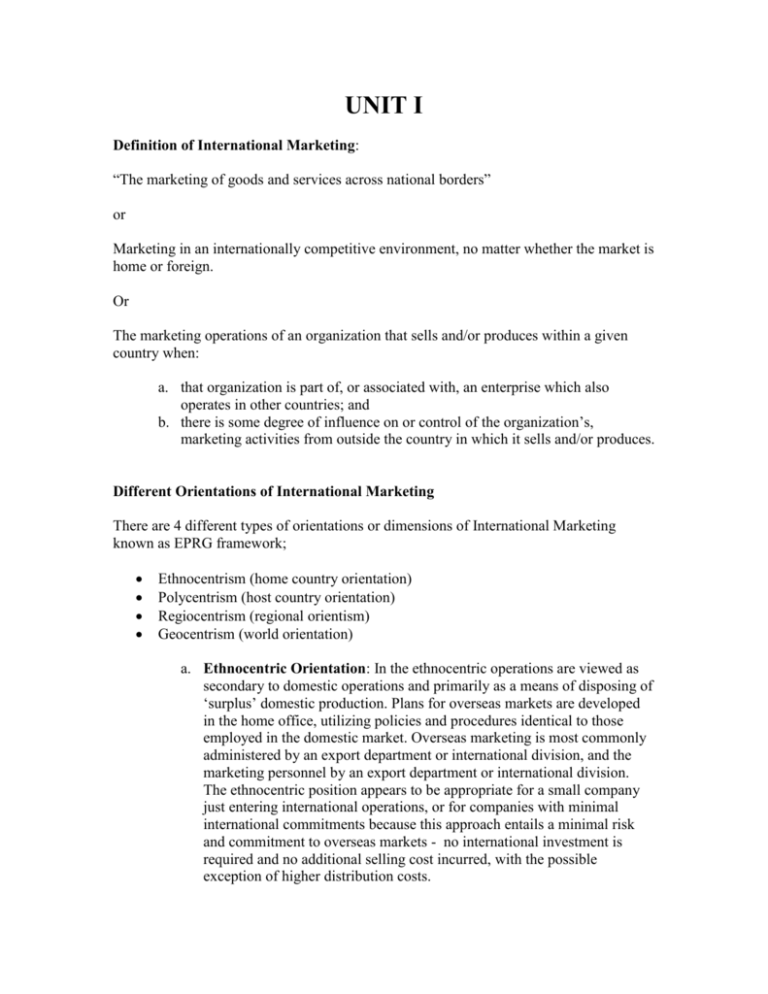
UNIT I Definition of International Marketing: “The marketing of goods and services across national borders” or Marketing in an internationally competitive environment, no matter whether the market is home or foreign. Or The marketing operations of an organization that sells and/or produces within a given country when: a. that organization is part of, or associated with, an enterprise which also operates in other countries; and b. there is some degree of influence on or control of the organization’s, marketing activities from outside the country in which it sells and/or produces. Different Orientations of International Marketing There are 4 different types of orientations or dimensions of International Marketing known as EPRG framework; Ethnocentrism (home country orientation) Polycentrism (host country orientation) Regiocentrism (regional orientism) Geocentrism (world orientation) a. Ethnocentric Orientation: In the ethnocentric operations are viewed as secondary to domestic operations and primarily as a means of disposing of ‘surplus’ domestic production. Plans for overseas markets are developed in the home office, utilizing policies and procedures identical to those employed in the domestic market. Overseas marketing is most commonly administered by an export department or international division, and the marketing personnel by an export department or international division. The ethnocentric position appears to be appropriate for a small company just entering international operations, or for companies with minimal international commitments because this approach entails a minimal risk and commitment to overseas markets - no international investment is required and no additional selling cost incurred, with the possible exception of higher distribution costs. b. Polycentric Orientation: As the company begins to recognize the importance of inherent differences in overseas markets, a polycentric attitude emerges. The prevalent philosophy at this stage is that local personnel and techniques are best suited to deal with local market conditions. Subsidiaries are established in overseas markets and each subsidiary operates independently of the others and establishes its own marketing objectives and plans. c. Regiocentric and Geocentric Orientations: A regiocentric company views different regions as different markets. A particular region with certain important common marketing characteristics is regarded as a single market, ignoring national boundaries. Objectives are set by negotiation between headquarters and regional HQ on the one hand and between regional HQ and individual subsidiaries on the other. A geocentric company views the entire world as a single market and develops standardized marketing mix, projecting a uniform image of the company and its products, for the global market. In general, the desirability of a particular international orientation – E, P, R, G – tends to depend on several factors, such as the size of the firm, the experience gained in a given market, the size of the potential market, and the type of the product and its cultural dependency. INTERNATIONALISATION STAGES Domestic Company: Most international companies have their origin as domestic companies. The orientation of a domestic company essentially is ethnocentric. A purely domestic company “operates domestically because it never considers the alternative of going international. The growing stage-one company, when it reaches growth limits in its primary market, diversifies into new markets, products and technologies instead of focusing on penetrating international markets. A domestic company may extend its products to foreign markets by exporting licensing and franchising. The company, however is primarily domestic and the orientation essentially is ethnocentric. International Company: International company is normally the second stage in the development of a company towards the transnational corporation. The orientation of the company is basically ethnocentric and the marketing strategy is extension, i.e, the marketing mix ‘developed’ for the home market is extended into the foreign markets. Multinational Company: When the orientation shifts from ethnocentric to polycentric, the international company becomes multinational. In other words, “when a company decides to respond to market differences, it evolves into a stage-three company is multinational that pursues a multi-domestic strategy. The focus of the stage-three company is multinational or, in strategic terms, multi-domestic (that is, the company formulates a unique strategy for each country in which it conducts business). Global/Transnational Company: According to Keegan, global company represents stage four and transnational company stage five in the evolution of companies. According to Keegan, the global company will have either a global marketing strategy or a global sourcing strategy but not both. It will either focus on global markets and source from the home or a single country to supply these markets, or it will focus on domestic market and source from the world to supply its domestic channel. The Transnational Corporation is much more than a company with sales, investments and operations in many countries. This company, which is increasingly dominating markets and industries around the world, is an integrated world enterprise that links global resources with global markets at a profit. International marketing Decisions (i) (ii) (iii) (iv) (v) International Business Decision: The first decision a company has to make, of course, is whether to take up international business or not. This decision is based on serious consideration of a number of important factors, such as the present and future overseas opportunities, present and future domestic market opportunities the resources of the company, company objectives etc. Market Selection Decision: The next important step is the selection of the most appropriate market. For this purpose, a thorough analysis of the potentials of the various overseas markets and their respective marketing environments is essential. Company resources and objectives may not permit a company to do business in all the overseas markets. A proper selection of the overseas market(s), therefore, is very important. Entry and Operating Decisions: The next important task after the market selection decision is to determine the appropriate mode of entering the foreign market. Marketing Mix Decisions: The foreign market is characterized by a number of uncontrollable and controllable variables. The marketing mix consists of internal factors which are controllable. The success of International marketing, therefore, depends to a large extent on the appropriateness of the marketing mix. The elements of the marketing mix should be suitably designed so that may be adapted to the characteristics of the overseas market. International Organization Decision: A company which wants to do direct exporting has also to decide about its organizational structure, so that the exporting function may be properly performed. This decision should necessarily be based on a careful consideration of such factors as the expected volume of export business, the nature of overseas market, product, size and resources and length of its export experience. Future of International Marketing 1. Globalisation of supply chain and operations management 2. International Investments 3. Information surge and consumer choice 4. World growth 5. Domination of the world economy 6. Trade cycle decison rule 7. Pervasiveness of free markets 8. Accelerating growth of global markets 9. The rise of the Internet and Information technology INTERNATIONAL MARKETING ENVIRONMENT The various environments that can be termed important for International marketing are: P – Political E – Economical S – Social T – Technological E – Environmental L – Legal D - Demographic Based on the syllabus of Ist Trimester from the subject of Marketing Management Unit I (Topic: Marketing Environment)
